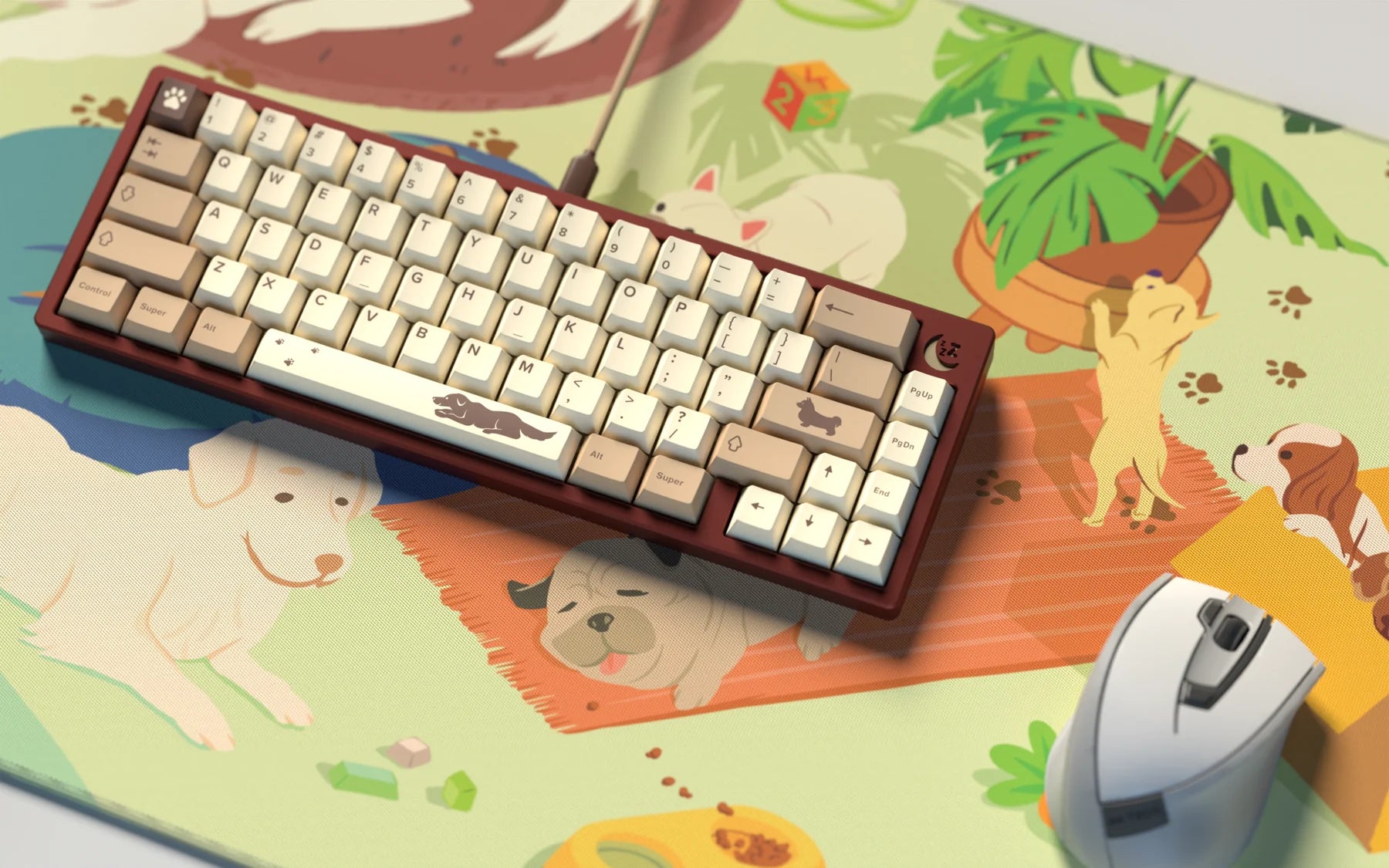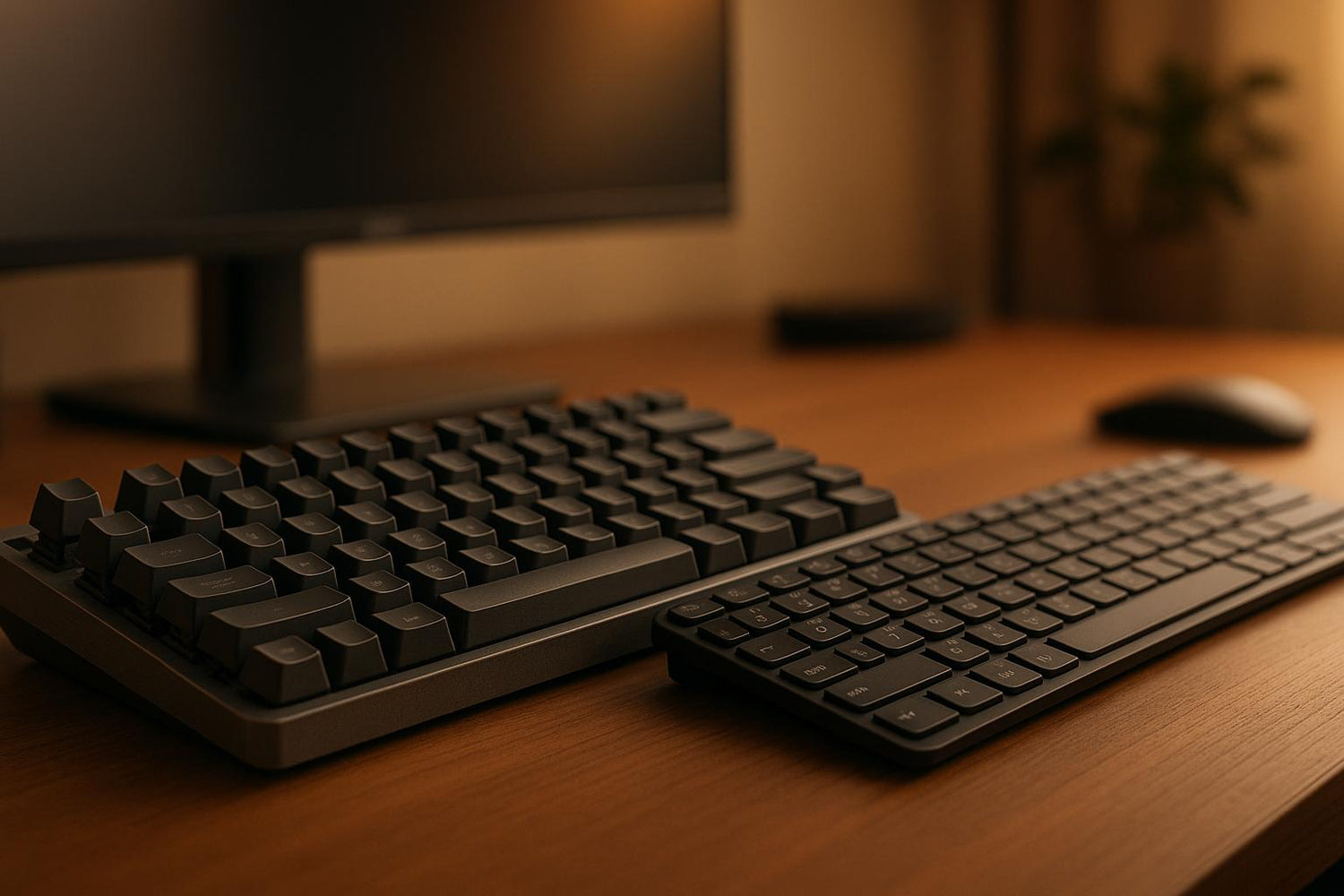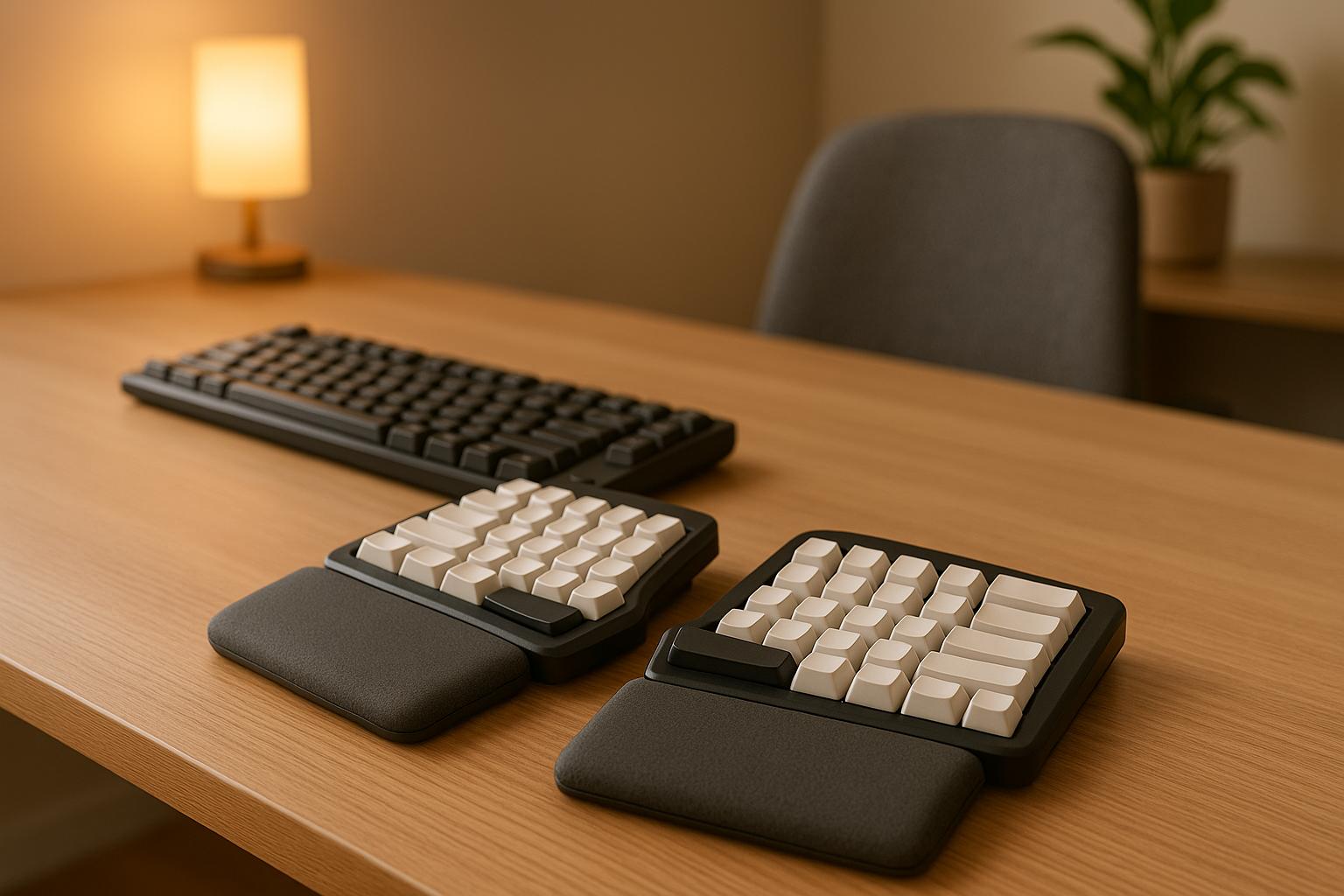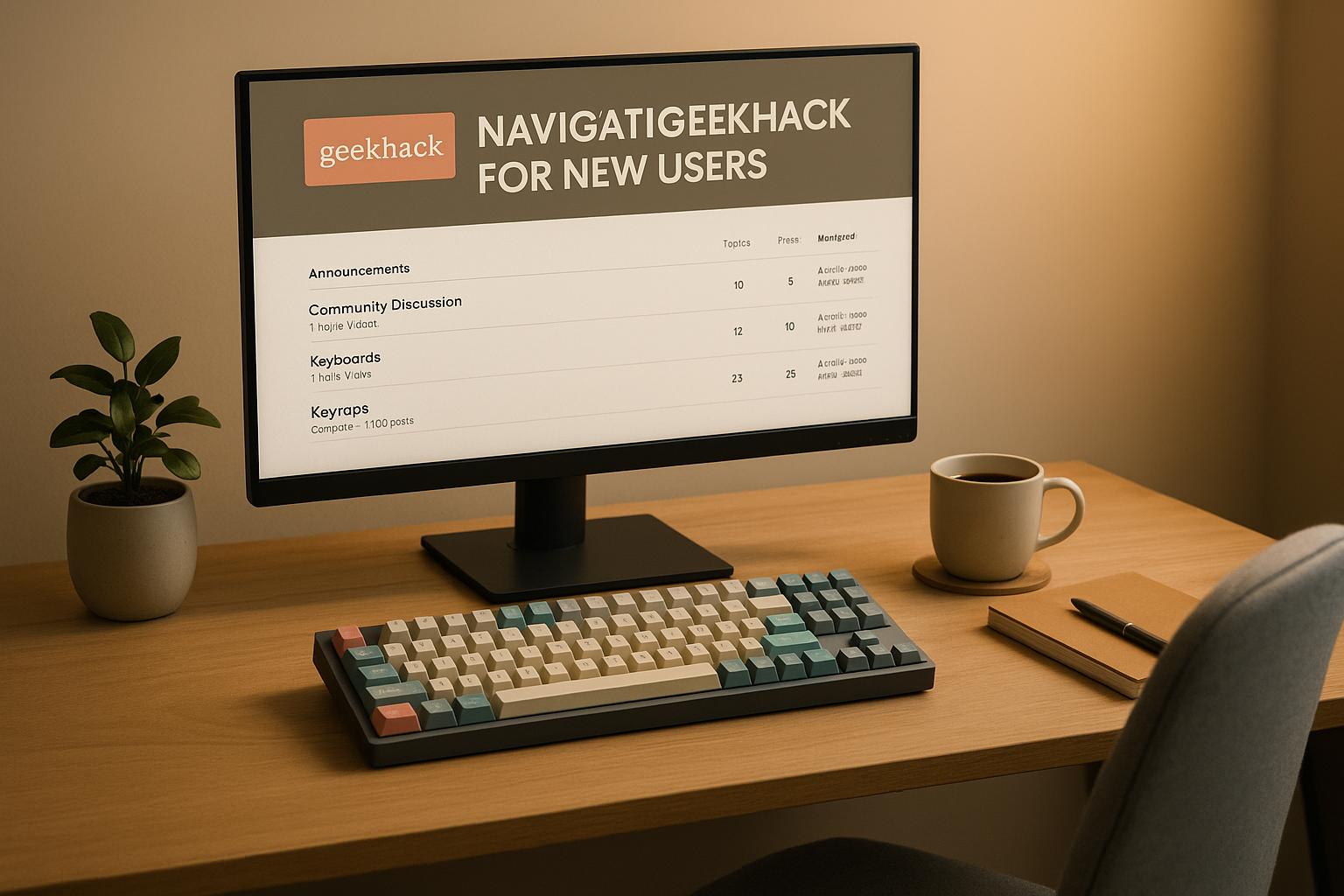Looking for a keyboard that lasts? Here's the bottom line:
- Mechanical keyboards last 10–15 years (50–100 million keystrokes) and are repairable.
- Membrane keyboards last 1–2 years (~5 million keystrokes) and often need full replacement.
Quick Comparison
| Feature | Mechanical Keyboards | Membrane Keyboards |
|---|---|---|
| Lifespan | 10–15 years | 1–2 years |
| Keystroke Rating | 50–100 million | ~5 million |
| Repairability | Replaceable parts | Full unit replacement |
| Cost Per Year | $10–$15 (mid-range models) | $10–$20 |
If you want durability, easy repairs, and long-term savings, mechanical keyboards are the better choice. Membrane keyboards are cheaper upfront but need frequent replacements. Keep reading for a detailed breakdown of costs, maintenance, and lifespan.
Design Elements That Affect Lifespan
Switch Types and Durability
When it comes to keyboard lifespan, the type of switch plays a major role. Mechanical keyboards are built with individual switches, often rated for 50–100 million keystrokes. Some specialized models even boast lifespans of up to 30 billion presses. In contrast, membrane keyboards rely on a rubber dome design, typically rated for around 5 million keystrokes. This fundamental difference impacts several features:
| Feature | Mechanical Switches | Membrane Switches |
|---|---|---|
| Replaceability | Individual switches | Single membrane layer |
| Tactile Feedback | Consistently maintained | Degrades over time |
| Failure Mode | Isolated switch failure | Entire membrane failure |
Mechanical keyboards are more durable in part because their switches can be replaced individually, whereas a failure in a membrane keyboard often means replacing the entire unit.
Materials and Construction
The materials and construction of a keyboard significantly influence its durability. Mechanical keyboards are typically made with high-quality plastics and metal components. For instance, PBT keycaps are known for their resistance to wear and shine, outperforming the more common ABS plastic. On the other hand, membrane keyboards are constructed with simpler plastic materials, making them more prone to wear and tear over time.
Long-term Usage Effects
Over years of use, mechanical keyboards are designed to maintain their performance, often lasting 10–15 years. In contrast, membrane keyboards tend to degrade, with tactile feedback becoming less reliable and actuation inconsistent. Additionally, membrane layers are vulnerable to damage from moisture and debris, which can accelerate performance issues and lead to failure.
Lifespan Testing Results
Testing vs Daily Use
Lab tests show that mechanical switches outlast membrane keyboards in terms of durability. However, real-world conditions - like exposure to dust, temperature changes, and varying typing pressure - also play a role in how long they last. With proper care, mechanical keyboards can reliably function for 10–15 years, while membrane keyboards typically need replacing after 1–3 years. These findings emphasize how design impacts longevity and pave the way for discussions on repair and maintenance.
Most Common Breaking Points
Understanding common failure points sheds light on how different keyboard designs handle extended use. Mechanical keyboards often face issues such as individual switch failures or key chatter. Membrane keyboards, on the other hand, are more prone to problems like rubber dome wear and decreased responsiveness, which frequently lead to replacing the entire unit.
| Failure Point | Mechanical Keyboards | Membrane Keyboards |
|---|---|---|
| Primary Issue | Individual switch failure | Deterioration of the membrane |
| Early Signs | Key chatter or inconsistent actuation | Mushy feel and reduced responsiveness |
| Time to Failure | 5–10+ years | 1–2 years |
| Repair Options | Replace individual switches | Replace entire keyboard |
Summary of Durability and Maintenance Ratings
| Metric | Cherry MX Switches | Gateron Switches | Topre Switches | Membrane Switches |
|---|---|---|---|---|
| Rated Keystrokes | 100 million | 50 million | 100+ million | 5 million |
| Average Lifespan | 10–20 years | 8–15 years | 10–20 years | 1–2 years |
| Maintenance | Minimal | Minimal | Minimal | Not serviceable |
These numbers highlight the durability of mechanical switches, which are built to handle millions of keystrokes and far outlast membrane keyboards. In fact, mechanical keyboards can last 6–14 times longer than their membrane counterparts. This durability plays a key role in determining repair needs, maintenance, and the overall cost of ownership.
Repair and Maintenance Options
Parts Replacement Guide
One of the standout features of mechanical keyboards is how easy they are to repair. Thanks to their modular design, you can fix specific components instead of replacing the entire keyboard. For example, if a key switch stops working, you can simply remove and replace it. This is a huge advantage over membrane keyboards, which are far more challenging to repair due to their integrated design.
Here’s a quick look at some common mechanical keyboard components and how easy they are to replace:
| Component | Ease of Replacement | Tools Required | Skill Level |
|---|---|---|---|
| Key Switches | High | Switch puller, soldering iron (if not hot-swappable) | Beginner–Intermediate |
| Keycaps | High | Keycap puller | Beginner |
| Case Parts | Medium | Screwdrivers, plastic cement | Intermediate |
| Mounting Plate | Medium | Screwdrivers, hex keys | Intermediate |
Once you’ve completed repairs, regular maintenance is key to keeping your keyboard in top shape.
Maintenance Steps
For Mechanical Keyboards:
- Remove and clean keycaps monthly using a keycap puller.
- Use compressed air to blow out dust and debris from between the switches.
- Clean the switch housings with isopropyl alcohol and cotton swabs for a deeper clean.
- Apply lubricant to switches when necessary to ensure smooth operation.
- Inspect and tighten any loose mounting screws to maintain stability.
For Membrane Keyboards:
- Wipe the surface weekly with a slightly damp, lint-free cloth to keep it clean.
- Use compressed air to clear debris from between keys.
- Avoid using liquid cleaners that could damage the membrane layers.
- Regularly check the membrane layer for any signs of separation or damage.
- Keep the keyboard away from moisture and heat to prevent warping or malfunction.
Repair Cost Breakdown
When it comes to repair costs, mechanical keyboards are far more economical in the long run. Their modular design allows you to replace individual components, such as switches or keycaps, without breaking the bank. On the other hand, membrane keyboards lack this flexibility. If something goes wrong, you’ll often need to replace the entire keyboard, which can be less cost-effective over time.
sbb-itb-3cb9615
Total Ownership Costs
Purchase Price vs Lifespan
When comparing mechanical and membrane keyboards, the differences in cost and lifespan are clear. Membrane keyboards are budget-friendly, typically priced between $10 and $30, whereas mechanical keyboards start at around $50 for basic models, with mid-range options costing $100 to $150, and high-end models reaching $200 to $500.
The lifespan of each type creates a noticeable gap in long-term value:
| Keyboard Type | Initial Cost | Average Lifespan | Cost Per Year |
|---|---|---|---|
| Basic Membrane | $20 | 1–2 years | $10–20 |
| Basic Mechanical | $50 | 5–15 years | $3.33–10 |
| Mid-range Mechanical | $150 | 10–15+ years | $10–15 |
This table highlights how the lifespan of mechanical keyboards contributes to their long-term affordability. Let’s break this down further with a cost analysis over 5 and 10 years.
5-Year and 10-Year Cost Analysis
Here’s how the costs stack up for membrane and mid-range mechanical keyboards over 5 and 10 years.
5-Year Cost Analysis:
-
Membrane Keyboard
- Initial cost: $20
- Requires 2–3 replacements during this time
- Total cost: $60–$80
-
Mid-range Mechanical Keyboard
- Initial cost: $150
- Routine maintenance: ~$20–$30
- Occasional switch or keycap replacements: ~$30–$50
- Total cost: $200–$230
10-Year Cost Analysis:
-
Membrane Keyboard
- Initial cost: $20
- Requires 5–6 replacements over 10 years
- Total cost: $120–$140
-
Mid-range Mechanical Keyboard
- Initial cost: $150
- Additional supplies: ~$40–$60
- Replacement parts: ~$50–$100
- Total cost: $240–$310
While membrane keyboards may seem cheaper upfront, their shorter lifespan leads to frequent replacements, which adds up over time. On the other hand, mechanical keyboards, though more expensive initially, offer durability and the ability to replace individual components, making them a cost-effective choice for heavy users in the long run.
For long-lasting and high-performance mechanical keyboards, check out KeebsForAll for options tailored to your needs.
Final Comparison
Main Points Summary
Mechanical keyboards clearly outshine membrane keyboards when it comes to durability and lifespan. The numbers speak for themselves: mechanical switches are rated for 50–100 million keystrokes, while membrane keyboards typically manage only 5–10 million keystrokes.
| Feature | Mechanical Keyboards | Membrane Keyboards |
|---|---|---|
| Average Lifespan | 10–15 years | 1–2 years |
| Durability | Rated for millions more clicks | Basic click rating |
| Repairability | Replaceable parts simplify repairs | Full replacement needed |
| Build Quality | Precision switches | Basic membrane design |
These durability factors not only extend the keyboard's functional life but also simplify repairs and maintenance. When paired with the cost analyses from earlier, it’s clear that mechanical keyboards offer better long-term value.
Benefits of Mechanical Keyboards
The extended lifespan of mechanical keyboards comes with several key benefits:
Sturdy Construction
Mechanical keyboards are built to last. Premium switches, like Cherry switches, are tested to handle up to 100 million activations, ensuring years of reliable performance.
Effortless Maintenance
One of the standout features is the ability to replace individual components. This makes it easy to perform upgrades or routine fixes, significantly extending the keyboard's usability.
Long-Term Savings
With proper care, a single mechanical keyboard can last 10–20 years. In contrast, membrane keyboards often need replacing every 1–2 years, making mechanical options far more economical over time.
Friedrich Stiemer from PCWorld sums it up perfectly:
"Mechanical keyboards offer a longer lifespan, a better typing experience, and significantly reduced electronic waste."
For a durable and reliable typing experience, check out KeebsForAll's mechanical keyboards, designed to stand the test of time.
Mechanical vs Membrane Keyboards - What's the difference?
FAQs
Why do mechanical keyboards last longer than membrane keyboards?
Mechanical keyboards are known for their longevity, thanks to their sturdy components and thoughtful design. Unlike membrane keyboards, which are rated for about 5 to 10 million keystrokes, mechanical switches can handle an impressive 50 to 100 million keystrokes. This makes them a reliable choice for anyone who types frequently or plans to use their keyboard for years.
Another standout feature is the use of premium materials, such as PBT keycaps. These keycaps are resistant to wear and oil buildup, maintaining their look and feel even after extensive use. Plus, the modular design of mechanical keyboards means you can replace individual switches or keycaps as needed, rather than replacing the entire keyboard. These qualities make mechanical keyboards a durable and cost-effective option in the long run.
What is the long-term cost difference between mechanical and membrane keyboards?
Mechanical keyboards may seem pricier upfront compared to membrane keyboards, but they often prove to be a smarter investment over time. Thanks to their durability, mechanical keyboards can last anywhere from 5 to 10 years, with many switches rated for 100 million keystrokes. In contrast, membrane keyboards usually need replacing after just 1 to 3 years.
Take this example: a $40 membrane keyboard might require multiple replacements, adding up to more than the cost of a single $100 mechanical keyboard that can serve you reliably for years. Plus, mechanical keyboards allow for customization and repairs, which can further stretch their lifespan. For anyone prioritizing reliability and long-term savings, they’re a solid choice.
How can I maintain my keyboard to make it last longer?
To keep your keyboard in top shape and extend its lifespan, a little routine care goes a long way. Start with regular cleaning to clear out dust and debris. If you have a mechanical keyboard, carefully remove the keycaps and use compressed air to clean the area beneath them. For membrane keyboards, a soft cloth paired with a mild cleaner works well for wiping down the surface.
For mechanical keyboards, you might also consider lubricating the switches from time to time. This can minimize wear and improve how the keys feel when pressed. If the keycaps start to look or feel worn, swapping them out for new ones can make a big difference. No matter what type of keyboard you use, be sure to keep it safe from liquids and humidity. When it's not in use, store it in a clean, dust-free spot to avoid unnecessary damage.



![[Pre-Order] Autumn Leaves PBT Keycaps - KeebsForAll](http://keebsforall.com/cdn/shop/products/DSC09732.jpg?v=1676148273)






Leave a comment
This site is protected by hCaptcha and the hCaptcha Privacy Policy and Terms of Service apply.